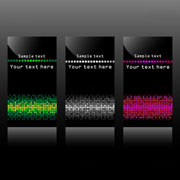 Business letterheads usually include a logo, a return address, and a telephone number. Direct marketers have found that the design of the letterhead can impact response to a promotion letter.
For promotion letters, it is best to design a letterhead unique to each letter, one that is tailored to the style of the letter copy varying the logo, color, or even return address. For example, a fund-raising campaign letter for a nonprofit organization might utilize a simple black-and-white letterhead rather than the organization's usual twocolor embossed, gothic-type letterhead that might look too rich.
Some marketers have rented post office boxes in a location suitable to their product, such as a Washington, D.C., box to use as a letterhead address for a political fund-raising campaign or a Florida P.O. Box to use for a cruise line. Some marketers believe that a color letterhead will generate a higher response than a black-and-white letterhead, regardless of the promotion type, because the color increases the reader's level of interest in the letter.
Business cards are printed on some form of card stock, the visual effect, method of printing, cost and other details varying according to cultural or organizational norms and personal preferences. The common weight of a business card varies some by location. Generally, business cards are printed on stock that is 350g/m2 (density), 45 kg (100 lb.) (weight), or 12pt (thickness).
High quality business cards without full-color photographs are normally printed using spot colors on sheet-fed offset printing presses. Some companies have gone so far as to trademark their spot colors (examples are UPS brown, Los Angeles Lakers' purple, and Tide's orange). If a business card logo is a single color and the type is another color, the process is considered two color. More spot colors can be added depending on the needs of the card. With the onset of digital printing, and batch printing, it is now cost effective to print business cards in full color.
To simulate the "raised-print" effect of printing with engraved plates, a less-expensive process called thermography was developed that uses the application of a plastic powder, which adheres to the wet ink. The cards are then passed through a heating unit, which melts the plastic onto the card. Spot UV varnish onto matte laminate can also have a similar effect.
Full color cards, or cards that use many colors, are printed on sheetfed presses as well; however, they use the CMYK (cyan, magenta, yellow, and black) four-color printing process. Screens of each color overprinted on one another create a wide gamut of color. The downside to this printing method is that screened colors if examined closely will reveal tiny dots, whereas spot color cards are printed solid in most cases. Spot colors should be used for simple cards with line art or non-black type that is smaller than 5 points.
Some terminology in reference to full color printing:
- 4/0 - Full Color Front / No Print On Back
- 4/1 - Full Color Front / One color On reverse
- 4/4 - Full Color Front / Full Color Back
These names are pronounced as "four over zero," "four over one," or "four over four".
A business card can also be coated with a UV glossy coat (offset-uv Printing). The coat is applied just like another ink using an additional unit on a sheetfed press. That being said, UV coats can also be applied as a spot coating - meaning areas can be coated, and other areas can be left uncoated. This creates additional design potential.
Business Cards can also be printed with a digital copier, which uses toner baked onto the surface of the card. Some industry leaders have begun avoiding the using the term copier in their literature, insisting their state-of-the-art machines are more like digital presses, than their office-oriented predecessors.
While some of the older office copiers may have had problems running heavy business card stock, the newest digital presses can print on stock as heavy as 80# to 100# cover stock, and 12 to 14 point stocks with ease.
UV coats, and other coatings such as Aqueous Coatings are used to speed manufacturing of the cards. Cards that are not dry will "offset" which means the ink from the front of one card will end up on the back of the next one. UV coatings are generally highly glossy but are more likely to fingerprint, while aqueous coatings are not noticeable but increase the life of the card. It is possible to use a dull aqueous coating on uncoated stock and get some very durable uncoated cards, and using UV coating or plastic lamination can also be applied to thicken thin stocked cards and make them more durable as well.
When cards are designed, they are given bleeds if color extends to the edge of the finished cut size. (A bleed is the extension of printed lines or colors beyond the line where the paper it is printed on will be cut.) This is to help ensure that the paper will cut without white edges due to very small differences in where the blade cuts the cards, and it is almost impossible to cut the cards properly without. Just being a hair off can result in white lines, and the blade itself will pull the paper while cutting. The image on the paper can also shift from page to page which is called a bounce, which is generally off by a hairline on an offset press, but can be quite large on lower end equipment such as a copier or a duplicator press. Bleeds are typically an extra 3.175 (1⁄8) to 6.35 mm (1⁄4 in) to all sides of the card.
Bleed Size: 95.25 × 57.15 mm (3.75 × 2.25 in) (1⁄8 in bleeds)
- Standard Cut Size: 89 × 51 mm (3.5 × 2 in)
- Fold-over or "tent" cards, and side fold cards are popular as well. Generally these cards will fold to the standard size.
|